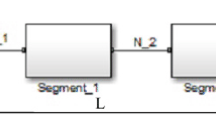Abstract
The regeneration of transient flow phenomena in pressurized pipes is inevitable because it is part of the operating principle of a system that might be put in place. However, a good understanding of the phenomenon enables to control it in order to limit its harmful effects which threaten the functioning of the transport system. In this regard, this article falls within that context. A digital model has been developed to describe the phenomenon of transient flows in pressurized pipes at any point in the network. Although the significant pressure drops in the networks are reduced, the phenomenon cannot be solved by the pressure pulsations and the speeds generated by the transient flows, and that requires permanently a mean of damping it. However, the right solution is not always possible. For double and triple effect pumping stations, this work has the ability to follow the parameters of the transient flow in the time and space. The mathematical models, inspired from the Saint Venant equations, might be particularly possible to set up a program of discretization of the network, the calculation of all the parameters necessary for the nodes and for each element of discretization, the determination of the boundary conditions on the left and the right of the nodes thus the calculation of the parameters in transient flow. This program also made it possible to graphically visualize, at the time and at the desired node in the network, the variation in pressure and flow. However, the specificity of the first point of the network as well as the junction point of the pipes led to follow the path of the parameters at these places.




















Similar content being viewed by others
References
Amara L, AchourB and Berreksi A (2013a) Numerical approach to finite volumes for calculation the dynamic response of equilibrium chimneys. Larhyss J 14:7–19
Amara L, Berreksi A, Achour B (2013b) Adapted MacCormack finite-differences scheme for water hammer simulation. J Civ Eng Sci 2(4):226–233
Camichel C, Eydoux D, Gariel M (1916) Theoretical and experimental study of water hammer, Ann Sci Fac Toulouse 3e serie, tome 8
Hammoum H, Yahiaoui A, Achour B (2015) Water hammer analysis in a penstock in the event of a valve closing. Part 1: without pressure losses. Journal of materials and engineering structures,, n°0/2015, PP.000-000.
Hammoum H, Yahiaoui A, Achour B (2017) Water hammer analysis in a penstock in the event of a valve closing. Part 2: pressure drops concentrated downstream.Journal of materials and engineering structures, n°4/2017, PP.99-109.
Meunier. Maurice (1980). Water hammer and protection of pressurized water networks. 198 pages. ENGREF edition, Paris.
Ouragh (1971) Y Hydraulic forced flow, vol II, Paris Edition
Piskonov N (1995) Differential and integral calculus, vol II, First part, university publications office (UPO), corrected edition
Salah B, Massouh F (2010) Application of Lame model on a pressure pipe with single or lined walls and placed in a trench, Review of the Houille Blanche n°4, pp 90-95
Salah B, Massouh F, Kettab A and Mbangangoye B (2001) Celerity of the water hammer wave in buried network, Review of the Houille Blanche, n° 3/4
Thirriot CL (1967) Approximate methods of calculating water hammer in relatively long pipes, Review of the Houille Blanche, n°2
Author information
Authors and Affiliations
Corresponding author
Ethics declarations
Conflict of interest
The authors declare that they have no competing interests.
Additional information
Responsible Editor: Murat Karakus
Rights and permissions
About this article
Cite this article
Toumi, A., Remini, B. Resolution of the Saint Venant equations: a case of double and triple effect pumping stations. Arab J Geosci 15, 14 (2022). https://doi.org/10.1007/s12517-021-08269-8
Received:
Accepted:
Published:
DOI: https://doi.org/10.1007/s12517-021-08269-8




